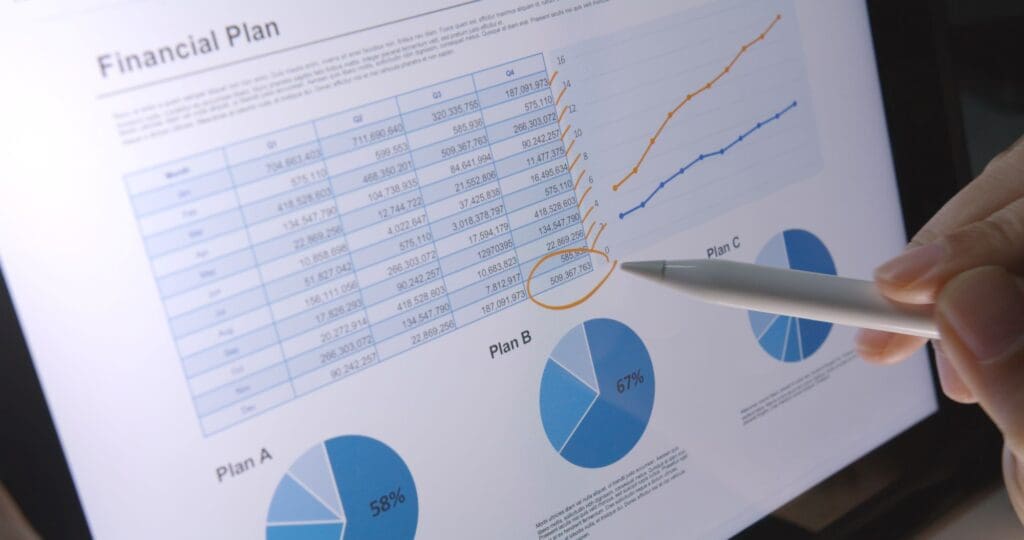
How To Write A Financial Plan For Your Small Business
Last updated 31/01/2024
Let’s talk about how to write a financial plan for your small business. Many business owners often ignore the most important aspects of managing their business’s finances. And that includes creating a financial plan.
Here’s a question for you: do you have a financial plan for your small business?
Writing a financial plan is not glamorous, but it’s crucial in preparing your business plan. While it is important to work with your accountant regarding your business finances, including creating a financial plan, you can DIY.
What’s A Financial Plan?
Generally, financial planning refers to the process of evaluating an organization’s current financial status, identifying future goals, and creating forecasts for growth. It covers several areas, including budgeting, forecasting, and strategic allocation of resources.

Why Financial Planning Matters
I know that everything accounting and finance can seem overwhelming for many business owners. However, beyond the numbers on that financial planning spreadsheet is a proactive and dynamic approach to managing your business’s financial health.
Here’s why a financial plan is important:
- For clarity and direction – it provides a clear picture of your financial goals and the steps needed to achieve them, keeping you focused and your actions aligned with your aspirations.
- Making informed decision-making – data-driven insights from your plan guide critical decisions about resource allocation, investments, and expansion strategies.
- Proactive risk management – by identifying potential risks and developing contingency plans, you can minimize their impact and ensure business continuity even in turbulent times.
- Improved cash flow management – understanding your income and expenses empowers you to anticipate fluctuations and make informed choices about inventory, staffing, and other crucial areas.
- Increased profitability – analyzing financial data allows you to identify areas for improvement and optimize your operations, ultimately leading to greater profitability.
Key Components of a Comprehensive Financial Plan
A solid financial plan has several components, each playing a pivotal role in the overall financial health of your business. These include:
Budgeting
Budgeting involves the allocation of financial resources to different parts of the business. This includes operational expenses, capital expenditures, and strategic investments. A well-structured budget provides a financial map, guiding your business toward fiscal responsibility and sustainability.
Cash Flow Management
Cash flow management is one of the most ignored parts of a business. Yet, it’s also one of the key areas of assessing the health of your business. As the saying goes, cash is king. Effective cash flow management involves monitoring the inflow and outflow of funds to ensure liquidity.
Forecasting
Anticipating future financial trends is a cornerstone of financial planning. Sales forecasting, expense projections, and market trend analysis contribute to a forward-looking strategy. Accurate forecasting enables the organization to adapt to changing market dynamics and make informed financial decisions.
Risk Assessment
Assessing and mitigating risks is inherent to financial planning. Identifying potential pitfalls, whether economic downturns, supply chain disruptions, or regulatory changes, allows businesses to proactively implement contingency measures, safeguarding financial stability.
Capital Structure Management
Evaluating the composition of a company’s capital—whether through equity, debt, or retained earnings—is integral to financial planning. Striking a balance ensures optimal leverage and capital efficiency, paving the way for sustainable growth.
Financial Analysis
Regular analysis of financial statements, key performance indicators, and ratios provides a diagnostic view of the business’s fiscal health. This analytical scrutiny allows for timely adjustments and strategic realignment as needed.

How to Write a Financial Plan for Your Small Business
Here’s a guide on how to write a solid financial plan for your small business:
Defining and Setting Goals
You’ve got to start somewhere, right? And the first step is to set your business’s goals. Financial planning aligns business objectives with financial goals. These goals, whether short-term or long-term, should adhere to the SMART criteria—Specific, Measurable, Achievable, Relevant, and Time-bound. Do you want to achieve a 20% revenue increase this year? Open a new location in the next two years?
Setting SMART goals will guide you and your team with resource allocation, ensuring efficiency and reducing waste. It also fosters a sense of purpose within the organization.
Conduct a Financial Assessment
Next, you must assess where you are. This step is more important if your business is already up and running.
Take stock of your current financial situation. Analyze your income streams, expenses, debts, and assets. This paints a clear picture of your starting point and informs your future projections.
Conduct Market Research and Industry Analysis
Don’t operate in isolation. It’s important to understand your industry’s trends, competitor landscape, and broader economic factors that might impact your business. This knowledge helps you make informed decisions aligned with market realities.
Create a Sales Forecast
A sales forecast is a projection of how much you will sell at a specific period. Therefore, projecting sales is crucial in planning and eventually achieving the desired profitability level.
Sales will largely depend on your advertisement level; hence it’s wise to consider promotion strategies and determine how they affect sales.
Estimate Profit And Loss
A profit and loss statement projection shows your expected revenues, expenses, and profit for a particular period or accounting cycle.
You determine profit by subtracting all the expenses from revenues. Your costs include total operating expenses such as; salaries, rent, utilities, raw materials, maintenance costs, storage, distribution, and promotion.
If you are starting your business, you will add startup expenses such as; business registration fees, other licensing and permit fees, starting inventory, rent deposit, property and equipment down payments, and utility setup fees.
Related post: Understanding Profits vs Cash Flow For Your Small Business
Estimate Your Cash Flow Projections
These are estimates of how cash is expected to flow in and out of your business. For example, how much money do you expect to receive or pay in a particular period, like a month, quarter, or year?
Projecting sales is different from projecting cash flows. Some customers cause this difference because they are slow in making payments; hence your business can be making profits but still run out of cash and vice versa.
Estimating cash flows enables you to determine if you will have enough money or if you will need extra funds. Look at your cash flow statement and plan for contingencies. It would help if you had a plan because sometimes there may be no cash, and unexpected events occur. Therefore, you have to be optimistic and pessimistic when preparing a financial plan.
Read more about Cash Flow Management for Small Businesses
Forecast The Balance Sheet
A balance sheet is a statement that shows the financial position of your business. It shows how your business is performing. How many assets do you project to have at the end of a financial year? List your financial year’s expected liabilities and assets to have a clear picture of future growth. The main components of your balance sheet are:
Assets
Assets include everything your business owns—for example, cash, buildings, land, and inventory.
Liabilities
What do you owe others? They include account payables and loans. Your liabilities are divided into current and long-term according to the order in which they will be paid.
Owner’s Equity
You calculate owner’s equity by subtracting your total liabilities from your total assets. It is the portion of the assets that belong to the owners.
Find Your Break-Even Point
A Break-even point is when your total costs are equal to your total revenues. You need to know your break-even point to lay down the strategies required to make your business profitable.
How much income do you need to cover your total costs? If you know this, anything above it is counted as your profit.

Create a Budget
Next, create a budget. This is where you allocate your projected income to various expense categories like marketing, payroll, and inventory. This ensures responsible resource allocation and helps you track your progress against your plan.
Identify and Mitigate Risks
No journey is without its challenges. Analyze potential risks specific to your business, such as economic downturns, supply chain disruptions, or legal issues. Develop contingency plans to address these risks and minimize their impact.
Regularly Monitor and Review
Financial planning is not a one-time exercise. It’s an ongoing process that evolves alongside your business. Regularly monitor your progress, compare actual results to projections, and adapt your plan as needed. It’s important to be flexible and responsive to changing circumstances.
Seek Professional Guidance
Consider engaging financial experts, utilizing advanced tools and software, and collaborating with accountants and advisors. Their expertise can provide valuable insights, ensuring that your financial plan is well-informed and tailored to the specific needs of your business.
The Bottom Line
Making a financial plan for your small business can feel overwhelming, but it is an essential step in strategizing and making decisions. Therefore, this process should be a regular part of your business. Even if you hire an accountant to do the work for you, you should go through the documents and make decisions appropriately as a business owner.
Every small business wants to grow, and this needs funding. With a well-written financial plan, you have a high probability of securing funding from investors. You can go further and prepare business ratios. These ratios help you understand your net profit margin, return on equity, accounts payable turnover, working capital, and total debt to total assets.
FAQ
Is financial planning really necessary for my small business?
While it’s not mandatory, financial planning will provide your business with a structured framework for managing your business’s financial resources. It helps you set clear goals, allocate resources effectively, and navigate the uncertainties of the business landscape, contributing to long-term sustainability and success.
How often should I review my financial plan?
You should review your financial plan regularly. Aim for a quarterly assessment, but at a minimum, conduct a comprehensive review annually. This ensures your financial plan remains aligned with your business goals and adaptable to changing market conditions.
How can I ensure my financial plan is realistic and achievable?
Base your projections on historical data, industry trends, and realistic assumptions. Regularly compare actual results to your plan and adjust as needed to maintain its relevance.
What happens if my financial plan doesn’t go as expected?
Remain flexible and adaptable. Regularly review your plan and adjust your strategies based on changing circumstances. Unexpected events are inevitable, but a well-constructed plan equips you to navigate them effectively.
How can I improve my business’s cash flow?
You can improve your business’s cash flow by managing receivables and payables efficiently. That includes negotiating favorable terms with suppliers and implementing strategies to accelerate the collection of receivables. Regularly monitoring cash flow patterns allows for timely adjustments.
Should I seek professional assistance for financial planning?
Yes, seeking professional guidance is advisable. Financial experts, accountants, and advisors can provide valuable insights and ensure that your financial plan is aligned with best practices and tailored to your business’s specific needs.






